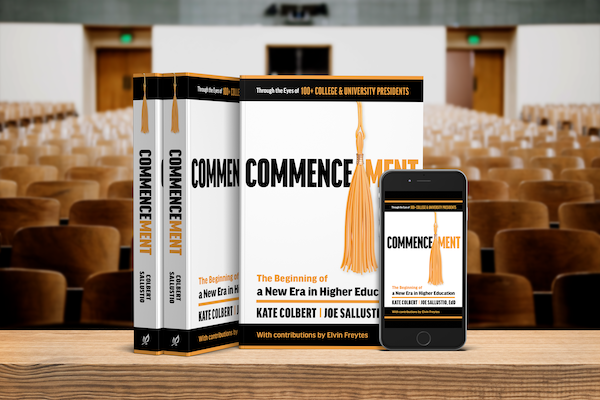Published on
Fitting the College Experience into Already Full Lives

This article is excerpted from Commencement. This specific piece is from Chapter 3: Where Did All the Students Go?
As institutions of higher learning seize the opportunity to serve students who are 24+, the challenges will be many. A decent portion of today’s college and university leadership teams were themselves educated when college was the only thing on their “to-do” list — when they were taking classes full time, living on campus, and free from the responsibilities of families or jobs. It was “all homework, all the time” (well, not all the time … there were football games and frat parties and student clubs). Today’s higher-education decision-makers can invariably relate now to the complex lives of adult students, but they rarely have a frame of reference for having juggled it all at once. Dr. Frank J. Dooley, Chancellor of Purdue University (based in West Lafayette, Indiana), told us how his institution thinks about flexibility for busy students. He said:
“As an online institution of working adults, one of the things that we find for our students is that sometimes life gets in the way. And by that, I mean something could have come up at work. Something could be health related. And so, we’re fairly liberal on our policy for withdrawals, with the notion, you know, ‘Come back to us in six or seven weeks when life is going to work for you again.’”
I nearly wept with validation upon hearing those words. I was once a student for whom “life got in the way.” And when an appeal all the way to the president’s office during my own undergraduate experience got me nowhere in terms of compassion for my situation (a medical diagnosis in the middle of an academic term, and a need to have urgent surgery), I was forced to remain in classes and on campus in terrible pain for another seven weeks because my family could not afford for me to withdraw and pay to repeat the courses after my surgery. I put my college ahead of my health because there was no “medical leave of absence” policy to help me; it was an impossible situation and one in which I, as a student, had no control. Today, students have so much more control and garner so much more respect. Time and time again, as Dr. Joe Sallustio and I conducted the research and participated in the conversations for this book, we discovered that higher education is so much more thoughtful, strategic, compassionate, impactful, and student-centered than it was when we cracked open our first college textbooks. For all the ways in which the 100+ presidents told us that the future is bright, I can’t help but observe that even the present is a lot brighter than our past. The higher-education industry is evolving to serve students better than before.
Leaders at institutions of all kinds are talking candidly about — and developing new policies and processes around — gap years and breaks. Dr. Stephen Spinelli, Jr., President of Babson College in Wellesley, Massachusetts, told us:
“I think understanding goes a long way in this, and colleges and universities need to be very understanding. ‘You need to take some time off? You need to take a lower course load? You need to come back in a year?’ We’ve got to make this easy for you to do that, or as easy as possible for you to do that, and then open our arms and welcome people back and stay connected with them while they’re away. It’s not, you know, ‘Goodbye and we’ll see you in a year.’ It’s ‘Can we check in? Can we have Student Life interface in this period that you’re away so that you feel connected to what’s happening?’ And we need to ask ourselves if there are ways to make those connections more human.”
How does your institution operationalize on such a promise? Does your admissions team have dedicated staff who oversee a sort of “win-back program” through which lapsed students are contacted and nurtured back into the fold? I worked for one institution that hired (as contractors) our own former admissions professionals — those who knew our school and our admissions requirements well, and who had left employment with us when they took a career break to raise family or to attend to other priorities. They understood, as well as anyone, that “life happens” and they were able to connect with lapsed students and bring many of them back. Truly savvy institutions will develop or maintain such a program in an ongoing manner, not just when they are desperate for tuition dollars. Frankly, all students who step away deserve to be nurtured, remembered, and communicated with — if those students have responded in the affirmative when asked whether they’d like the relationship with the college or university to continue. Busy people who have had a “college interrupted” experience often still hope to come back and are just looking for life to ease up — or for their college to find ways to make a return more flexible and achievable.
As we think about populations of students who are incredibly busy or committed to non-college endeavors, there is perhaps no other community more “committed” than those who are enlisted in the armed forces. And yet, there are higher-education opportunities even for this audience. Dr. Dooley shared that Purdue University Global has a program with the Army, through which new recruits can earn an associate’s degree during their first two years in uniform, with half of their credits coming from the Army training they’re already receiving and the other half coming from coursework with the university. He suggests, in fact, that the future of higher education might involve many colleges and universities wrapping their programs around the training that students are getting elsewhere (in the military, on the job, etc.). In this way, the university program becomes the wrapper or adjuvant to the primary activity, which is the job or the military training.
Older learners, working learners, lifelong learners — the presidents interviewed for this book told us that they are the future. Dr. David Finegold, President of Chatham University in Pittsburgh, Pennsylvania, said:
“I think the future of higher education is going to be informed by an intersection of several forces, like the huge growth in online education and the opportunity to serve older learners. We’ve invested heavily in online education, and we see that as a huge part of the future, particularly for older learners — people who are returning to education and juggling education with work. I’m a huge believer in thinking about education over the whole lifespan. As we’re seeing people living 30 to 40 more years after they so-called ‘retired,’ there’s going to be a huge future around thinking about ‘How do we tap their full potential over that lifespan?’”
Dr. Finegold was one of several leaders whose word choices made us sit up and take notice. I continually observed that expansive thinkers and open-minded leaders are talking about “learners” instead of “students” and sometimes “post-secondary education” instead of “higher education.” The opportunity to learn life skills and job skills after leaving high school is more likely to be embraced by diverse groups of people if the industry itself becomes more inclusive in its language.
Learn more at www.CommencementTheBook.com. Books are available on Amazon and everywhere books are sold.

Author Perspective: Administrator



